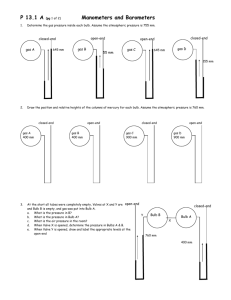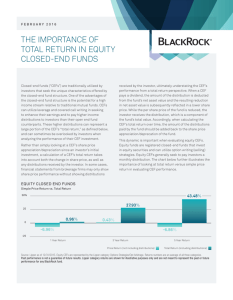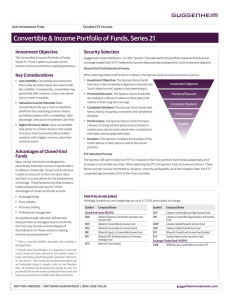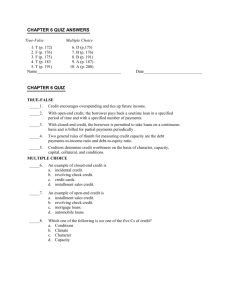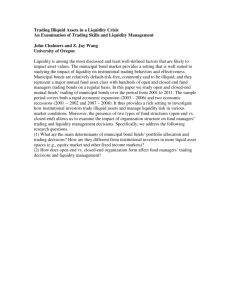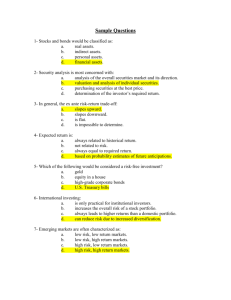frequently asked questions about closed-end funds
advertisement
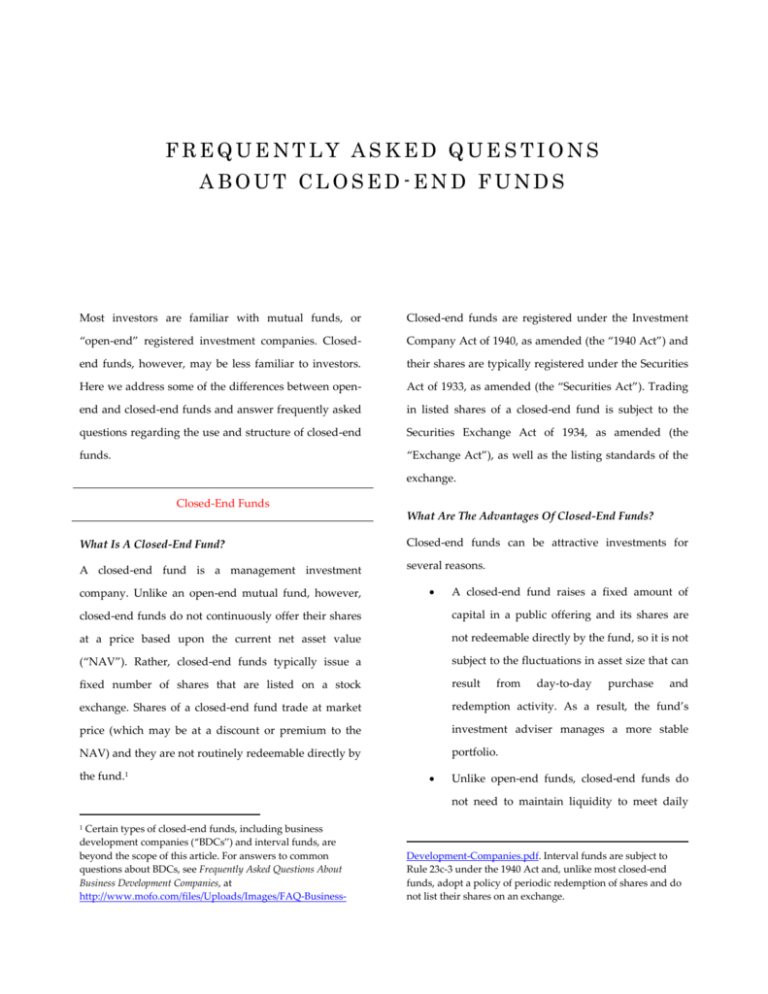
FREQUENTLY ASKED QUESTIONS ABOUT CLOSED-END FUNDS Most investors are familiar with mutual funds, or Closed-end funds are registered under the Investment “open-end” registered investment companies. Closed- Company Act of 1940, as amended (the “1940 Act”) and end funds, however, may be less familiar to investors. their shares are typically registered under the Securities Here we address some of the differences between open- Act of 1933, as amended (the “Securities Act”). Trading end and closed-end funds and answer frequently asked in listed shares of a closed-end fund is subject to the questions regarding the use and structure of closed-end Securities Exchange Act of 1934, as amended (the funds. “Exchange Act”), as well as the listing standards of the exchange. Closed-End Funds What Are The Advantages Of Closed-End Funds? What Is A Closed-End Fund? Closed-end funds can be attractive investments for A closed-end fund is a management investment several reasons. company. Unlike an open-end mutual fund, however, A closed-end fund raises a fixed amount of closed-end funds do not continuously offer their shares capital in a public offering and its shares are at a price based upon the current net asset value not redeemable directly by the fund, so it is not (“NAV”). Rather, closed-end funds typically issue a subject to the fluctuations in asset size that can fixed number of shares that are listed on a stock result exchange. Shares of a closed-end fund trade at market redemption activity. As a result, the fund’s price (which may be at a discount or premium to the investment adviser manages a more stable NAV) and they are not routinely redeemable directly by portfolio. the fund.1 from day-to-day purchase and Unlike open-end funds, closed-end funds do not need to maintain liquidity to meet daily Certain types of closed-end funds, including business development companies (“BDCs”) and interval funds, are beyond the scope of this article. For answers to common questions about BDCs, see Frequently Asked Questions About Business Development Companies, at http://www.mofo.com/files/Uploads/Images/FAQ-Business1 Development-Companies.pdf. Interval funds are subject to Rule 23c-3 under the 1940 Act and, unlike most closed-end funds, adopt a policy of periodic redemption of shares and do not list their shares on an exchange. redemptions. Thus, they have more flexibility Registration with the SEC subjects a fund to certain to invest in less liquid securities. Closed-end funds have more other filing requirements (see “Open-End and Closed-End Funds at a Glance” below). regulatory flexibility than open-end funds to leverage Post-Effective Amendments to Registration Statements their investments. For example, they may issue Generally, closed-end funds amend their registration preferred shares or debt, which open-end statements by filing a post-effective amendment as funds may not do. (For more information on required by the rules under the Securities Act. These the use and structure of leverage, see “Can rules require the SEC to review and declare effective Closed-End Funds Use Leverage?” below.) any post-effective amendments, which can delay a fund’s attempt to raise additional capital. (By contrast, How Does A Closed-End Fund Register With The SEC? the SEC’s rules allow open-end funds and interval Initial Registration funds to file post-effective amendments that become Like any registered investment company, a closed-end immediately effective, provided that they contain only fund must file a notification of registration on Form updated financial information or certain other non- N-8A. If the fund intends to publicly offer its shares, it material changes.)2 must then prepare and file a registration statement on Shelf Registration Statements Form N-2, a three-part registration statement consisting The SEC’s Staff has granted relief allowing closed-end of a prospectus, a statement of additional information funds to file Form N-2 to effect a shelf registration (“SAI”) and certain other information. statement for a delayed and continuous offering of The prospectus is designed to provide shares.3 This relief, however, did not allow post- shareholders with essential information about effective amendments to Form N-2 to become effective the fund and should be written in clear, automatically upon filing. concise language (i.e., plain English). Subsequently, the Staff addressed the issue of The SAI is designed to provide interested automatic effectiveness of post-effective amendments to shareholders with additional, more detailed Form N-2 on a case-by-case basis. In these individual information about a fund, its management and “no-action” letters, the Staff said that it would not service providers, and its policies. The SAI recommend enforcement action if certain closed-end must be available to shareholders on request for free. Interval funds may rely on Rule 486(b) and open-end funds may rely on Rule 485(b), each of which enables a registrant to file an immediately effective post-effective amendment primarily for the purposes of updating financial information or making other non-material changes. 3 See, e.g., Pilgrim America Prime Rate Trust (pub. avail. May 1, 1998); Nuveen Virginia Premium Income Municipal Fund (pub. avail. Oct. 6, 2006). The SEC’s Division of Investment Management generally allows third parties to rely on no-action letters if their facts and circumstances are substantially similar to those described in the previously granted no-action letter. 2 Other information included in the registration statement includes corporate organizational documents and certain contracts and compliance policies. 2 funds relied on Rule 486(b) under the Securities Act to such as directors and certain executive employees. file immediately effective post-effective amendments to “Insiders” must report their ownership at the inception their Form N-2 registration statements to bring financial of the fund and at least annually thereafter. Section 16 statements up to date or make other non-material also imposes certain trading restrictions on insiders. For changes.4 The Staff granted several of these no-action example, insiders of a closed-end fund cannot benefit requests under substantially similar circumstances. from a sale and purchase (or purchase and sale) of fund However, each letter specifically states that other shares made within six months of each other. Insiders registrants may not rely on the relief. Thus, a closed-end are required to disgorge any benefit of these “short- fund that wants to maintain a continuously effective swing” transactions. shelf registration statement and does not want to incur Why Does A Fund Trade At A Premium Or A Discount? the additional time, and possibly expense, of waiting for the Staff to review and declare effective amendments to When shares of closed-end funds trade on a stock its Form N-2 registration statement may consider exchange, their price will fluctuate like those of other seeking similar no-action relief. publicly traded stocks. That is, shares usually trade at a market price that is higher (at a premium) or lower (at a What Are The Requirements For Listing Shares Of A discount) than a fund’s NAV. Closed-End Fund? Many factors may determine whether a fund trades at Closed-end funds that list their shares on a stock a premium or a discount to its NAV. Sometimes public exchange are subject to the listing requirements of the perceptions can drive the market price of a closed-end relevant exchange. As described in more detail below, fund up or down in relation to its NAV. For example, if these requirements can include corporate governance the market perceives that a closed-end fund is one of the requirements (e.g., audit committee independence and only ways to invest directly or indirectly in a category required contents of the audit committee charter), of scarce securities, market interest may drive the price requirements for annual shareholder meetings, and of shares to a premium. On the other hand, a closed-end certain required reporting. In the case of a listing on the fund with a large unrealized capital gain may trade at a NYSE, the chief executive officer of a listed closed-end discount if investors believe that they may be subject to fund must annually certify to the NYSE that she is not tax if the fund realizes a capital gain. aware of any violation by the fund of NYSE listing How Can A Closed-End Fund Minimize A Discount? standards. A listed closed-end fund is subject to the reporting Historically, shares of closed-end funds tend to trade at requirements of Section 16 of the Exchange Act with a discount to NAV after the initial public offering. Fund respect to holdings of fund shares by certain insiders, management may take steps to minimize the size of the discount. For example, from time to time a closed-end fund may make a tender offer for outstanding common See, e.g., Aberdeen Asia-Pacific Income Fund, Inc. (pub. avail. June 26, 2013); Credit Suisse High Yield Bond Fund and Credit Suisse Asset Management Income Fund, Inc. (pub. avail. June 26, 2013); Eaton Vance, et al. (pub. avail. June 26, 2013). 4 shares and allow shareholders to redeem shares at NAV. Some closed-end funds have adopted a stock 3 purchase plan pursuant to which the fund purchases voting securities, which sets forth, among other things, shares on the open market to reduce the total number of the periodic intervals at which repurchases will be common shares outstanding. A closed-end fund may made. also choose to address a discount by adopting a policy Can A Closed-End Fund Raise Capital Through An At- to convert to an interval fund or to an open-end fund.5 The-Market Offering? (See “Can a Closed-End Fund Repurchase its Shares?” Yes. At-the-market offerings allow a closed-end fund to below.) raise capital quickly by selling newly issued shares into Can A Closed-End Fund Repurchase Its Shares? the natural trading flow of the market, without having As previously noted, closed-end fund shares generally to announce the offering. As a result, shares “trickle” trade on the secondary market at a market price that into the market without meaningfully affecting the may be at a premium or at a discount to a fund’s NAV. market price of a fund’s shares. The distribution costs If shares trade at a discount, a closed-end fund may for at-the-market offerings are typically less than those attempt to reduce the spread through a tender offer for for traditional follow-on offerings. Moreover, the its shares. A tender offer is subject to the rules under the absence of an issuer commitment to sell means that Exchange Act and the rules of the exchange. there will be no sales below acceptable share prices. Closed-end funds may also decide to convert to At-the-market offerings may raise issues, however, “interval funds.” Rule 23c-3 under the 1940 Act because Section 17(a) of the 1940 Act prohibits principal provides that a closed-end fund can adopt a policy of transactions with certain affiliated persons of a fund, repurchasing between five percent and twenty-five including its principal underwriter. To the extent a percent of its outstanding common stock at periodic distribution agent in an at-the-market offering is intervals pursuant to repurchase offers made to all considered a “principal underwriter” during the entire holders of common stock. The purchase price must be term of an at-the-market offering, the distribution agent the fund’s NAV determined as of a specified date, may not be able to provide other services to the closed- which may be subject to a repurchase fee of up to two end fund during the term of the program, absent an percent of the repurchase proceeds. A closed-end fund exemption from the prohibitions of Section 17. To avoid that wishes to periodically tender for its shares must potential issues under Section 17(a), closed-end funds adopt a fundamental policy, which may only be may wish to structure such a program to provide for changed by a majority vote of the fund’s outstanding agency-only transactions or structure an arrangement between the closed-end fund and the distribution agent in such a way to ensure that the distribution agent is not Irrespective of whether the board adopts such a policy, shareholders of a closed-end fund may propose to convert the fund to open-end status by obtaining approval by shareholders. Including such a proposal in a proxy statement is subject to the proxy rules under the Exchange Act and the provisions of the fund’s articles of organization and by-laws. Subject to SEC rules, management of a fund may exclude such a shareholder proposal if shareholders do not have the power to require inclusion under the laws of the state of organization. 5 a “principal underwriter.”6 For more information about at-the-market offerings, see Frequently Asked Questions About At-the-Market Offerings, at http://www.mofo.com/docs/pdf/FAQAtTheMarketOfferings.p df. 6 4 What Types Of Investments Are Permissible For to all registered investment companies. Among other Closed-End Funds? things, these include: The board of directors of a closed-end fund is free to set Affiliated transactions. Section 17 of the 1940 Act the fund’s investment objectives and policies, subject to prohibits an affiliated person, sponsor or many of the same rules and restrictions regarding distributor permissible investments as are applicable to mutual company, including a closed-end fund, from funds. Like all registered investment companies, a engaging in principal transactions with the closed-end fund must disclose in its prospectus its fund. Such prohibited transactions generally investment objectives, its principal investment strategies include selling or buying any security or other and any restrictions on the types of investments it may property or borrowing from or loaning money make. It must also disclose whether its portfolio will be to the fund. The SEC has adopted several rules “diversified,” or “non-diversified” as required by that exempt funds from these prohibitions. Section 5(b)(1) of the 1940 Act. Because a closed-end These include Rule 17a-7 (governing cross- fund doesn’t need to meet daily redemption requests, it trades between affiliated funds), Rule 17a-8 may be easier for a closed-end fund to invest a non- (governing mergers involving affiliated funds) diversified or concentrated portfolio. and Rule 17e-1 (governing the payment of “usual The lack of daily redemptions also gives closed-end of and a registered investment customary” brokerage commissions to an affiliated broker). funds the flexibility to invest in securities that are relatively illiquid. These may include thinly traded Pricing and valuation. Although the price at securities, securities traded in countries with less which the shares of a closed-end fund trade is developed exchange mechanisms or less liquid markets, determined by the secondary market, a closed- municipal bonds that are not widely traded, or end securities issued by small companies. Closed-end funds calculate its net asset value. Closed-end funds may also have exposure to private startup companies must comply with the requirements that apply funded by venture capital. to all registered investment funds including, fund nevertheless must periodically among other things, the requirement to price The ability to invest in these types of securities, together with the ability to use leverage, means that portfolio securities for which market closed-end funds may be more volatile and more risky quotations are not readily available at fair than many open-end mutual funds. value as determined in good faith by the closed-end fund’s board of directors. Are Closed-End Funds Subject To The Same Compliance Restrictions As Open-End Mutual Funds? Code of Ethics. Rule 17j-1 requires closed-end funds (other than those that invest solely in In general, closed-end funds are subject to the same U.S. government securities, certain short-term rules and restrictions set forth in the 1940 Act that apply securities or shares of open-end funds) and their investment advisers and distributors to 5 adopt a code of ethics designed to prevent Preferred Shares their in As with preferred shares of any company, holders of fraudulent, deceptive or manipulative conduct. preferred shares have priority over any other class of Among other things, the code of ethics must shares with respect to distribution of assets and require certain “access persons” to periodically payment of dividends. In addition, Section 18 provides disclose their personal securities holdings and that holders of preferred shares of a closed-end fund transactions and, in some cases, to pre-clear have the right to elect two directors of the fund at all securities trades in their personal accounts. times.9 access persons from engaging Investments in Other Investment Companies. Section 12(d)(1)(A) of proposed plan of reorganization or any investment registered investment companies to invest in policy changes that require shareholder approval under securities Section 13 of the 1940 Act must be approved by a companies. issued limits by the other ability If a closed-end fund issues preferred shares, then any investment Section 12(d)(1)(C) limits the majority of the holders of preferred shares. ability of any investment company to purchase Notwithstanding the limitation as to the number of or otherwise acquire shares issued by a closed- classes of preferred stock that may be issued, a closed- end fund if, immediately after such purchase end fund may offer more than one series of that class, as or investment long as no series has priority over any other with company, together with other investment respect to distribution of assets or payment of companies in its fund complex, own more than dividends. acquisition, the acquiring 10% of the total outstanding voting stock of the Debt Securities closed-end fund. If a closed-end fund has issued debt, then it must maintain the 300 percent asset coverage level in order to Can Closed-End Funds Use Leverage? pay out dividends on common stock. If the fund Section 18 of the 1940 Act effectively limits the amount proposes to pay out dividends on preferred stock, it of direct leverage in which an investment company can must maintain an asset coverage level of at least 200 engage. This section limits a closed-end fund’s issuance percent on any issued senior debt. of an evidence of indebtedness, unless the fund has 300 Section 18 provides an impetus to maintain a percent asset coverage,7 and preferred stock, unless the minimum asset coverage level on debt at all times: if a fund has 200 percent asset coverage.8 fund fails to maintain 100 percent asset coverage for 12 consecutive months, debt holders will be entitled to In the case of debt securities, asset coverage is calculated as the ratio of the value of total fund assets, less all liabilities and indebtedness not represented by senior securities, to the aggregate amount of debt securities. 8 Asset coverage on preferred shares is the ratio of the value of the fund’s total assets, less all liabilities and indebtedness not represented by senior securities, to the aggregate amount of debt securities issued by a fund plus the aggregate of the involuntary liquidation preference of the preferred shares. 7 elect at least a majority of the members of the board of Additionally, Rule 18(a)(2)(C) provides that holders of preferred shares may elect a majority of directors if, at any time, dividends on preferred shares remain unpaid for two years. Preferred shareholders will continue to have this right until all dividends in arrears are paid. 9 6 directors. If a fund fails to maintain 100 percent asset they comply with the requirements of Section 18 or the coverage for 24 consecutive months, an event of default alternative requirement shall be deemed to have occurred.10 segregated account. Auction Rate Preferred Stock instruments that involve “implied” or “economic” to They cover may assets also with invest a in leverage, provided those investments are consistent Historically, some closed-end funds issued auction rate with their investment policies. preferred stock (“ARPS”). The dividend rate on ARPS is In general, these segregated accounts must be marked- determined by an auction managed by an independent to-market daily. third party. During the financial crisis, the auctions “failed,” meaning that there were more buyers than Some closed-end funds may establish credit lines sellers for the ARPS. While closed-end funds continued directly with banks or bank syndicates. Others may to pay ARPS-holders dividends at established rates form special purpose vehicles that issue commercial determined by a pre-existing formula, they were unable paper backed by a fund’s note, which is in turn backed to sell their shares because they became illiquid. Some by the fund’s assets or other sources of credit. closed-end funds redeemed, or repurchased, ARPS from Do Closed-End Funds Distribute Income? their holders at par. When a fund repurchases ARPS, Closed-end funds pay out investment income in the the cost of leverage to the fund may increase. form of dividends.11 In many cases, access to this income is attractive to income-seeking investors, so Other Forms of Leverage closed-end funds may adopt a managed distribution Certain investment transactions, for example, reverse policy designed to provide routine (e.g., quarterly) repurchase agreements, firm commitment agreements distributions and stable distribution amounts. Closed- and standby commitment agreements, may involve a end funds may also provide investors with the senior security, because a counterparty may have a opportunity to reinvest distributions automatically future claim to the fund’s assets that is superior to the through the operation of a dividend reinvestment plan. rights of fund shareholders. The SEC has said that if a Distributions of net investment income and net short- fund has “covered” its obligations under these types of term capital gains realized by a fund are taxable to transactions, the fund would not be deemed to have shareholders as ordinary income. Distributions of net issued a senior security. A fund could “cover” the capital gain (i.e., the excess of net long-term capital gain transaction by segregating liquid assets on its books that over net short-term capital loss) are taxable as long-term are sufficient to satisfy 100 percent of the fund’s capital gain, regardless of the length of time a obligations under the transactions, or entering into shareholder owns the shares with respect to which such transactions that offset the fund’s obligations. distributions are made. An additional 3.8 percent Closed-end funds may also use derivatives and similar portfolio techniques to create leverage, provided 10 See “How are Closed-End Funds Taxed?” Closed-end funds electing to be treated as regulated investment companies are required to distribute substantially all of their income and capital gains to shareholders annually. 11 Rule 18(a)(1). 7 Medicare tax will be imposed on certain net investment tender offers, additional public offerings of shares or income, including ordinary dividends and capital gain conversion to open-end status. distributions, of certain U.S. shareholders for years Like all fund directors, directors of a closed-end fund beginning after December 31, 2012. Reinvestment of are subject to corporate governance standards imposed dividends will not change the tax treatment of by state law, the federal securities laws and regulations dividends for shareholders. adopted under such laws. Thus, directors of a closedend fund owe a fiduciary duty to the fund to act in a How Are Closed-End Funds Taxed? manner that protects its interests, taking into account To avoid the imposition of federal tax at the fund level, the interests of all shareholders. Under Section 16 of the a closed-end fund must elect to be treated as a regulated 1940 Act, a closed-end fund must elect a board of which investment company (RIC) under Subchapter M of the at least 40 percent are not “interested persons” of the Internal Revenue Code of 1986, as amended (the fund (as that term is defined in the 1940 Act). Practically “Code”). Among other things, Subchapter M imposes speaking, however, most closed-end funds elect a board requirements related to the sources of income and that consists of at least 75 percent non-interested diversification of portfolio holdings. Like open-end directors in order to avail themselves of certain funds, a closed-end fund electing to be treated as a RIC exemptive rules adopted under the 1940 Act. under Subchapter M must distribute substantially all of The 1940 Act also requires the directors to carefully its income and capital gains to shareholders annually. monitor the fund for conflicts of interest between the If a fund does not qualify as a RIC or fails to satisfy fund and its service providers. And, as with any the 90 percent distribution requirement in any taxable registered investment company, investment advisory year, it would be taxed in the same manner as an agreements are subject to annual board review and ordinary corporation on its taxable income. In addition, renewal under Section 15(c) of the 1940 Act. distributions to shareholders would not be deductible in Directors of a closed-end fund must oversee the fund’s computing a fund’s taxable income. compliance with federal securities laws. They are Are There Special Corporate Governance Requirements required by Rule 38a-1 under the 1940 Act to approve, For A Closed-End Fund? and annually review, written policies reasonably designed to prevent violation of the federal securities As noted previously, closed-end funds listed on an laws by the fund and certain of its service providers. exchange must hold annual shareholder meetings, and The directors must also designate a Chief Compliance must provide all shareholders of record with a proxy Officer, whose designation and compensation is subject statement in advance of such meetings. In addition, to the approval of the fund’s board and who can be rules of a listing exchange generally require prompt removed from his role only with the approval of the public disclosure of material information. From time to fund board. Closed-end funds must adopt a code of time, directors of a closed-end fund may be asked to ethics, anti-money laundering policies, trade allocation consider extraordinary corporate transactions such as policies, whistleblower policies, proxy voting policies 8 and policies related to handling shareholder complaints Are Closed-End Funds Subject To The Sarbanes-Oxley and maintaining full and fair disclosure, among others. Act? Yes. Closed-end funds that are registered with the SEC Do Closed-End Fund Audit Committees Have Special are required to maintain internal controls over financial Rules? reporting as required by the Sarbanes-Oxley Act. They The board must appoint, from its members, an audit must committee meeting the independence standards of the also maintain and regularly evaluate the effectiveness of disclosure controls and procedures SEC and the exchange on which the fund is listed. The designed to ensure that information required in filings audit committee must have at least one “audit with the SEC is recorded, processed, summarized and committee financial expert” as that term is defined in reported in a timely manner. Item 407(d)(5)(ii) of Regulation S-K. This requirement is Closed-end funds are required to file Form N-CSR, the more stringent than the rule that applies to open-end certified shareholder report for registered investment funds, which must disclose whether or not their audit companies, on a semi-annual basis. Form N-CSR must committees have an audit committee financial expert, be accompanied by a certification of a fund’s principal and if not, why not. executive officer and principal financial officer(s) that, SEC rules require closed-end funds (as well as all among other things, they: public companies) to include in their annual report to shareholders a report from the audit committee stating are responsible maintaining that the committee: for disclosure establishing controls and and procedures and internal controls over financial reviewed and discussed the financial reporting and that such procedures have been statements with management; discussed the audit with designed to ensure that material information the fund’s regarding the fund is reported to such officers independent auditors; and confirmed that the auditors met independence regarding the reliability of financial reporting; standards; and to provide reasonable assurances have disclosed to the fund’s auditors and its recommended to the board of directors that the audit committee all significant deficiencies, audited financial statements be included in the any material weaknesses in the internal annual report to shareholders. controls over financial reporting and any fraud The fund must also disclose the names of each involving employees with a significant role in member of the audit committee, identify which the fund’s internal controls over financial member(s) of the audit committee are audit committee reporting. financial experts and state the fees paid to the Closed-end funds must file Form N-Q, the quarterly independent auditors. schedule of portfolio holdings, for their first and third fiscal quarters. The filing must include a certification of the fund’s principal executive officer and principal 9 financial officer(s) similar to that set forth above with compliance with disclosure obligations; and respect to Form N-CSR. compliance with other legal or regulatory Form N-SAR requires closed-end funds to disclose obligations. whether they have adopted a code of ethics for their _____________________ senior financial officers as required by Section 406 of the By Jay G. Baris, Partner, and Kelley A. Howes, Of Counsel, in the Investment Management Group of Morrison & Foerster LLP Sarbanes-Oxley Act, and if not, why not. The code of ethics required by the Sarbanes-Oxley Act should address: © Morrison & Foerster LLP, 2015 resolution of actual or apparent conflicts of interest between personal and professional relationships; 10 Status under the 1940 Act Pricing of Securities Leverage Restrictions Limits on Illiquid Securities Sale of Shares Redemption of Shares Marketing OPEN-END AND CLOSED-END FUNDS AT A GLANCE OPEN-END FUNDS CLOSED-END FUNDS A management company that offers Any management company other than an for sale or has outstanding any open-end company. redeemable security of which it is the issuer. A mutual fund issues or redeems its securities at a price based upon the net Closed-end fund shares trade in the asset value (NAV) next computed after secondary market and may be at a discount receipt of the order. Mutual funds or premium to the fund’s NAV. must compute NAV at least once daily. Can issue a senior debt security and a Senior debt is prohibited. senior equity security, subject to asset coverage requirements. Senior equity (e.g., preferred stock) is prohibited. Senior debt must maintain asset coverage of at least 300 percent or Must maintain asset coverage of at comply with alternative asset least 300 percent or comply with segregation requirements. alternative asset segregation requirements. Senior equity must maintain asset coverage of 200 percent. The SEC has taken the position that open-end funds should not invest No limit. more than 15 percent of net assets in illiquid securities. Closed-end funds sell a fixed number of shares in an IPO, after which investors generally buy shares of the fund in the Mutual funds continuously offer secondary market (on an exchange or shares to the public at a price based over the counter) at market price upon the current NAV (may be subject (subject to brokerage commission costs). to sales loads and other distribution fees). Closed-end funds may also issue shares in follow-on offerings and at-the-market offerings. Investors generally sell may sell shares of closed-end funds in the secondary market on an exchange at the market price. Open-end funds must be ready, willing and able to redeem shares at In order to reduce the discount at which the next-determined NAV (subject to shares may be trading, closed-end redemption fees, if any). funds may adopt stock repurchase programs or periodically tender for shares (subject to rules under the Exchange Act and proxy requirements). Typically, mutual fundsoffer shares Closed-end funds typically offer shares through a registered broker-dealer through a registered broker-dealer that that is a member of FINRA (brokeris a member of FINRA in a single 10 Exchange Listing Disclosure OPEN-END AND CLOSED-END FUNDS AT A GLANCE OPEN-END FUNDS CLOSED-END FUNDS dealers may charge distributionunderwritten public offering. related fees to investors). After the public offering, the shares of Rule 12b-1 governs the use of fund most closed-end funds are traded on assets primarily intended to finance exchanges. distribution. A closed-end fund must comply with rules Not applicable. of the exchange on which its shares are listed. Registration statement on Form N-2 is Registration statement on Form not required to be updated annually. N-1A must be updated at least annually. Annual shareholder meeting and proxy statement, consistent with the rules of No requirement for an annual the listing exchange and the Exchange shareholder meeting and proxy Act. statement (unless required by state law where the fund is organized). Closed-end funds that wish to make a repurchase offer must file notice of the Annual notice of securities sold offer on Form N23c-3. pursuant to Rule 24f-2. Semi-annual shareholder reports and Semi-annual shareholder reports filing certified reports on Form N-CSR. and filing certified reports on Form N-CSR. Form N-PX annual report of proxy voting record. Form N-PX annual report of proxy voting record. Form N-Q quarterly schedule of portfolio holdings. Form N-Q quarterly schedule of portfolio holdings. Semi-annual reports on Form N-SAR. Semi-annual reports on Form N-SAR. 11 Insider holding reports required by Section 16 of the Exchange Act (Forms 3, 4 and 5).

